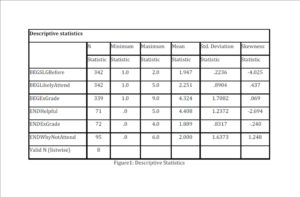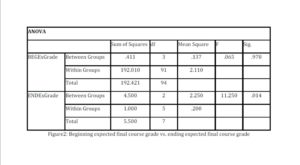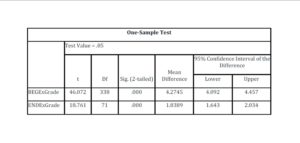Introduction
The relevance of Business school education, especially the expectations of graduates’ business decision making skills in the workplace, is under scrutiny (Tushman, O’Reilly, Fenollosa, Kleinbaum, & McGrath, 2007). Labour markets are demanding that graduates of business schools acquire critical numeracy skills that can provide a “seamless transition” to the workplace, yet a common refrain in recent scholarship, especially when it comes to management education, is that the business community’s needs are not being met (Hughes, Tapp, & Hughes, 2008; Tushman et al.; Currie & Knights, 2003; Ulijn, 2000). Introductory accounting courses constitute a key foundation of business school graduates’ competencies and as such they are fundamental in building the tools for business decision making and critical thinking skills (Etter, Burmeister & Elder, 2000)
Part of the problem, according to Dehler, Welsh and Lewis (2001), can be attributed to the rooted historical trend towards teaching students to learn management decision making principles “as a set of content’ areas,”. As a result, it may be denying the inherent complexity of managerial thought and practice. Hagen, Miller and Johnson (2003) similarly recognize this trend as the “restrictive thinking” of management education (p.242).
However, a study conducted by Malgwi (2006) shows that one third of the students perceived the first course in accounting to be significantly important to their future career, irrespective of their major and gender.
In order to truly enhance student learning and ensure more desirable learning outcomes of improved skill sets relevant in the labour markets, Dehler et al. (2001) contend a new approaches to business education are needed: “the complexity of managerial thinking and action needs to be reduced with sufficient clarity that students can comprehend its essence, while simultaneously raising their own level of complicatedness in order to grasp that extant complexity” (p. 494).
In particular, the first learning experience in an introductory accounting class can become a key factor (Cohen & Hanno, 1993) in deciding whether a career in accountancy should be pursued. Therefore, an SSI based teaching and learning pedagogy is a prerequisite condition for positively influencing positive student attitudes and perceptions for a successful career in accounting.
Given that there are requests in the literature for change, we are prompted to question whether adopting a conventional teaching pedagogy that includes a strict in-class, face to face instruction in accountancy is sufficient to develop a deeper, more nuanced understanding of the foundation skills required in accountancy.
By surveying students who took the (SSI) intervention strategy of implementing a critical pedagogy in the Business 143: Accounting I , we hope to better understand if and how a heightened awareness of the course content might further foster student engagement and ultimately improve upon students’ academic performance and help develop core business skills and competency badly needed in the labour markets . Such an interventionist strategy is ideal for better course and educational planning process whereby improving upon student retention rates, which has the potential of bringing about educational efficiency.
Literature Review
SSI supplemental instruction model was initiated at the University of Missouri in 1970. It intended to focus on students who were low achievers in their classes. In particular, this level of student marginality occurred in the introductory level courses which made it very difficult for such students to proceed unto upper level classes without acquiring fundamental skill set and the prerequisite knowledge (Blanc et al., 1983).
Similarly, the University of the Fraser Valley (UFV) in Abbotsford of BC, Canada also adopts this strategy and names it as SLG (Supplemental Learning Group) and defines it as:
“Supported Learning Groups (SLG) are student led study sessions designed to help you succeed in a course, and to help you improve your study skills and become a successful student at UFV. Whether you’re looking for that A+, just have a question, are struggling to pass, or simply want to study in a group” (https://www.ufv.ca/slg/about-slg/)
Since introduction in 1970, there has been considerable diffusion of SSI based programs in the United States (Fayowski & MacMillan, 2008). Prior studies have collected data and demonstrated considerable improvement with students enrolled in such programs (Martin & Arendale, 1992; Martin & Arendale, 1994). For instance, Rath, Peterfreund, Xenos, Bayliss and Carnal (2007) considered an institution-specific approach by measuring the impact of SSI on students enrolled in Introductory Biology at San Francisco State University (2007). Using the data from 1,526 students collected between 1999 and 2005, they found that SSI participants, on average, were more likely to earn a “C” grade or higher in the course. The authors also found students from marginalized backgrounds benefited most from participating in SSI since they were more likely to earn higher average grades in Introductory Biology and able to graduate from university (Queens Study, 2011).
Similarly, in Canada, SSI based programs was implemented. At Carleton University, Miles, Polovina-Vukovic, Litteljohn and Marini (2010) used data from 4,942 students compared SSI participants with non-SSI participants in various faculties. Results showed SSI participants achieved higher final grades than non-participants. Evidence from the University of Guelph and University of the Fraser Valley UFV show such similar positive results (Wilson, 2005). For instance, SLG participants at UFV show higher GPA achievement than non-participants. These students were less likely than non-participants to drop a course or not complete SSI based programs (UFV, 2010).
In sum, the literature shows that the benefits of SSI on student performance and retention are significant.
There is also substantive evidence that demonstrates that SSI based instruction has long-term positive impact on the students’ academic performance (Ogden, Thompson, Russell, & Simons, 2003).
The underlying issue for the proper implementation of a SSI based curricula is the inability of the post-secondary institution to implement SSI programs uniformly in their institutions. As a result, it ends up with, across all the introductory level courses, high levels of student failure. Also, that is an issue of diversity of their student intake. Canadian educational institutions have students who come from different cultures and ethnics with a variety of prior teaching and learning experience, which may negatively influence students’ success. This level of complexity challenges the instructional faculty and forces them to seek alternate or supplementary styles of teaching. This is where SSI based curricula becomes a feasible option of instruction. This level of challenge goes beyond seeking new instructional techniques and brings opportunities in critical pedagogy.
Dehler (2009) defined Critical pedagogy succinctly as “a mechanism for problematizing values and learning” (p.33) that ultimately fosters a “critical consciousness” (Boyce, 1996; as cited by Hagen et al., 2003, p.243). This allows for “an opening of vision” (Chia, 1996; as cited in Hagen et al., p.243) that has been regarded by some Business educators as a key to overcoming the pitfalls of simplified, instructor-centred curriculum. Such pedagogy can instead be implemented to enable educational training more relevant to the demands of the modern workplace and to assist educational development among faculty, too (Dehler et al., 2001).
This approach helps educational scholars to realize that a more idealized understanding of business education is not just “specialized skills but a wider and deeper understanding to be able to justify beliefs and behaviour” (Hagen et al., p.242-243). Achieving such a goal, however, according to Dehler, is largely contingent on extending beyond notions of “master[ing] a subject” (1996, p.222) to involve students in practices that sensitize them to the tacit social conditions shaping the work they do.
Therefore, (SSI) based teaching strategy could become an integral component of teaching and learning (Hurley, Jacobs & Gilbert, 2006; Arendale, 2000; Burmeister, Kenney & Nice, 1996). (SSI) based accounting education has been in use in the US schools of accountancy for years (Etter, Burmeister & Elder, 2000). The University of Missouri-Kansa City (UM-KC) developed the SI Model and implemented it very successfully in many of schools. Peer supported learning group (PSLG) strategies have been implemented in the Bachelor of Technology (BTech) courses in the Department of Electronic and Computer Engineering (ECE) in the UK universities (Mehdi, ?). Etter, Burmeister, and Elder (2000) used a meta-analytic model and examined the impact of SI on student success in Introductory Accounting classes. Their findings indicate student success in SSI based courses.
Similarly, a model of collaborative learning in small peer-led group settings has been introduced for the purpose of integrating instruction and reasoning skills with course content (Fayowski and MacMillan, 2008) has been very effectively tested and used in first year calculus courses at a small Canadian university. In the Canadian experience, it was found that the instructor office hours and a single tutorial did not suffice for improvement of students’ learning experience and that a more creative approach was needed. The SI model was chosen by the Canadian university for the purpose of “non-remedial image, learning and study skills in the context of the course and the programme’s guiding principles”
A call for (SSI) based teaching pedagogy can sensitize students to social conditions, something that can be articulated as the link between “tacit knowing and explicit knowledge” (Cunliffe, 2002). Cunliffe endorses a more dialogic approach to challenge traditional instructor-student power relations in the Business classroom and encourage greater self-reflection and reflexivity among students and instructor(s) alike: one aimed at fostering “thinking and meaning-centred” learning in Business education (Resnick & Klopfer, 1989; as cited in Dehler, 1996, p. 222).
In recognizing the transformative power of a student’s own experience, this approach resonates with Schon’s call for a “practitioner-oriented model of education [that requires] practitioners to become more reflective of their own activities” (1987; as cited in Schryer, 1994, p.106). It has been supported by the study of Lave and Wenger (1991) which influentially theorizes on legitimate peripheral participation.
Even though scholars like Cunliffe (2002) have contemplated the value of this more critical approach to Management education, few researchers have examined whether such pedagogy has been or should be most effectively implemented in the classroom setting (Currie & Knights, 2003). Also, it is worth noting at this point that Cunliffe and others typically have interrogated pedagogic theories related to MBA programmes in the US and UK. What happens, then, when one introduces a critical pedagogy in management courses more locally, at the undergraduate level – in a class of students preparing for both direct- entry into the workplace upon graduation as well as further academic study? Will intensifying students’ critical engagement in numeracy skills and awareness in the course through select pedagogic strategies better prepare these individuals for the “seamless transition” that employers and educators alike seek?
Recently, a pilot study completed at a Canadian University (2012) shows the following results on the SSI implementation strategy:
“Our findings suggest that the SLG program at Queen’s University has been an effective supplement to traditional academic resources such as seminars and lectures, and has shown signs of positive, although mixed, success during its pilot years by reinforcing academic best practices and providing guided study time for students who are at academic risk. We also assert that further research remains to be done to understand more fully the role of this program in supporting student success” (Queens, Pilot Study, 2012)
Research Question
Based upon our synthesis of the above-mentioned literature review, we developed the research question for our study as:
After attending the SSI sessions, do students perceive that SSI is helpful to improve their academic success?
Sample
This study surveyed the total population of 342 students taking first year accounting course at the University of the Fraser Valley (UFV) for their willingness to participate at the SSI program. As expected, there were lots of students showed initial interests to attend because in principle they all understood that SSI may be helpful for their first year’s accounting study. However, later on, when students really have to take the time to commit, prepare and attend each SSI class, in addition to their regular classes, then, the attendance dropped accordingly. Thus at the end of SSI classes, there were still 72 students attending SSI answered the survey and 95 students expressed their opinion on why they did not attend. We believe the response is valid to examine if students attending SSI will perceive that they will have better chance to achieve academic success in introductory accounting classes.
Method and Implications
Our study examined the level of success, as perceived by the attending students, in the pre- and post-SSI expectations; and how these initiatives have translated to GPA levels at the end of the semester. At the beginning of the semester, an orientation was held for the students registered in the SSI Program. As well, instructors who would oversee and provide support to course mentors (mainly high GPA senior students studying accountancy). A pre-term student was also administered in order to assess the students’ level of expectation from SSI participation. At midterm and the end of the semester, same students were asked to complete surveys to see if their expectations at the beginning of the semester yielded good GPA results as a consequence of SSI participation. All the three survey instruments are shown in the Appendix section of this paper.
Our goal in was to examine the overall effectiveness of the SSI strategies implemented in the first year accounting classes for a group of culturally diversified students. In particular, the study probed whether high-risk students who participated in peer-led SSI instruction did significantly improve their mean semester GPA in 2011 academic year.
Through this exploratory study, we aimed at cultivating and ultimately measuring students’ development in the face of this pedagogy. We expect to highlight dialogic exchange and reflection to foster the importance of explicit peer led instruction and practice in discourse analysis. Our goal was to gain insight in understanding participating students’ evolving critical engagement with and comprehension of the course material studied. As well, a quantitative dimension(s) to this project will consider some data mapping opportunities for better counseling and educational planning opportunities
.
A factorial variance model will be used to better understand the data that has already been collected. It is expected that with more advanced statistical analysis, we will have a better understanding of the underlying constructs behind success via the SSI intervention strategy.
Key Findings and Results
Figure 1 show the descriptive statistics measured on all the variables. BEGSLGBEFORE and END HELPFUL variables provide negative skewness values indicating that the bulk of the scores are the higher end of data spectrum. The rest of the measurement variables indicate data scores at the lower end of the spectrum.
Conclusion and Practical Implication
1. Arendale, D. (1994). Understanding the supplemental Instruction model, in Supplemental Instruction: increasing achievement and retention, D.C Martin and D. Arendale, eds., Jossey Bass, Inc., San Fransisco, CA pp.11-22.
2. Blanc, R.L., DeBuhr, L., & Martin, D. (1983). Breaking the attrition cycle. Journal of Higher Education, 54 (1), 80-90.
Publisher – Google Scholar
3. Cunliffe, A. (2002). Reflexive dialogical practice in management learning. Management Learning, 33(1), 35-61. Retrieved July 15, 2011 from Sage Management & Organization Studies-CSA database.
Google Scholar
4. Currie, G., & Knights, D. (2003). Reflecting on a critical pedagogy in MBA Education. Management Learning, 34(1), 27-49. Retrieved July 2, 2009 from Sage Management & Organization Studies-CSA database.
Publisher – Google Scholar
5. Dehler, G. (1996). Management education as intentional learning: A knowledge-transforming approach to written composition. Journal of Management Education, 20(2), 221-235. Retrieved July 15, 2011 from Sage Management & Organization Studies-CSA database.
Publisher – Google Scholar
6. Dehler, G. (2009). Prospects and possibilities of critical management education: Critical beings and a pedagogy of critical action. Management Learning, 40(1), 31-49. Retrieved August 18 from Sage Management & Organization Studies-CSA database.
Publisher
7. Dehler, G., Welsh, A., & Lewis, M. (2001). Critical pedagogy in the ‘new paradigm.’ Management Learning, 32(4), 493-511. Retrieved July 26, 2011 from Sage Management & Organization Studies-CSA database.
Publisher – Google Scholar
8. Etter, E.R., Burmeister, S.L., & Elder, R.J. (2000). Improving Student Performance and Retention via Supplemental Instruction. Journal of Accounting Education, 355-368.
9. Fayowski, V., and MacMillan, P.D. (2008). An Evaluation of the Supplemental Instruction Programme in the First Year Calculus Course. International Journal of Mathematical Education, Vol. 39, No.7.
Google Scholar
10. Hagen, R., Miller, S., and Johnson, M. (2003). The ‘disruptive consequences of introducing a critical management perspective onto an MBA programme. Management Learning, 34(2), 241-257. Retrieved August 22, 2009 from Business Source Premier database.
Publisher – Google Scholar
11. Hodges, Russ (2001). Encouraging High-Risk Student Participation in Tutoring and Supplemental Instruction. Journal of Development Education, Vol.21, Issue3.
Google Scholar
12. Hughes, T., Tapp, A., & Hughes, R. (2008). Achieving effective academic/practitioner knowledge exchange in marketing. Journal of Marketing Management, 24(1-2), 221-240. Retrieved August 5, 2011 from Business Source Premier database.
Publisher – Google Scholar
13. Hurley, M., Jacobs, G., Gilbert, M. (2006). The Basic SI Model. New Directions for Teaching and Learning, No.106, Summer.
Google Scholar
14. Lave, J., & Wenger, E. (1991). Situated learning: Legitimate peripheral participation. Cambridge: Cambridge University Press.
Publisher – Google Scholar
15. Mahdi, Abdulhussain E. (1999?). Introducing Peer-Supported Learning A[[roach to Tutoring in Engineering and Technology Courses. International Journal of Electrical Engineering Education, 43/4.
16. Martin, D.C., & Arendale, D. R. (1992). Supplemental instruction improving first-year student success in high risk courses (2nd ed. Monograph No. 7). Columbia, SC: National Resource Centre for the Freshmen Year Experience, University of South Carolina.
17. Martin, D.C., & Arendale, D. R. (1994). Supplemental Instruction: Review of research concerning the effectiveness of SI from the University of Missouri-Kansas City and other institutions from across the United States. National Center for Supplemental Instruction, University of Missouri-Kansas City. Accessed May 2011, available at: http://www.eric.ed.gov/ERICWebPortal/search/detailmini.jsp?_nfpb=true&_&ERICExtSearch_SearchValue_0=ED3705
02&ERICExtSearch_SearchType_0=no&accno=ED370502
18. Malgwi, C.A . (2006). Discerning Accounting and Non-Accounting Students’ Perceptions in the first Course in Accounting as a Proxy for Separate Course Delivery. Global Perspectives on Accounting Education, Volume 3, 67-91
Google Scholar
19. Rath, K.A., Peterfreund, A.R., Xenos, S.P., Bayliss, F., & Carnal, N. (2007). Supplemental Instruction in Introductory Biology I: Enhancing the performance and retention of underrepresented minority students. Life Sciences Education, 6(3), 203-216 Schryer, K. 1994. The lab vs. the clinic: Sites of competing genres. In A. Freedman & P. Medway (Eds.), Genre and the new rhetoric (pp. 105-124). London: Taylor & Francis.
Google Scholar
20. Tushman, M., O’Reilly, C., Fenollosa, A., Kleinbaum, A., & McGrath, D. (2007). Relevance and rigor: Executive education as a lever in shaping practice and research. Academy of Management Learning & Education, 6(3), 345-362. Retrieved August 6, 2011 from Business Source Premier Database.
Publisher – Google Scholar
21. Ulijn, J. (2000). Innovation and international business communication: Can European research help to increase the validity and reliability for our business and teaching practice? Journal of Business Communication, 37(2), 173-187. Retrieved August 5, 2011 from Business Source Premier Database.
Google Scholar
Appendix
Survey administered as students enrol in the SSI Program









